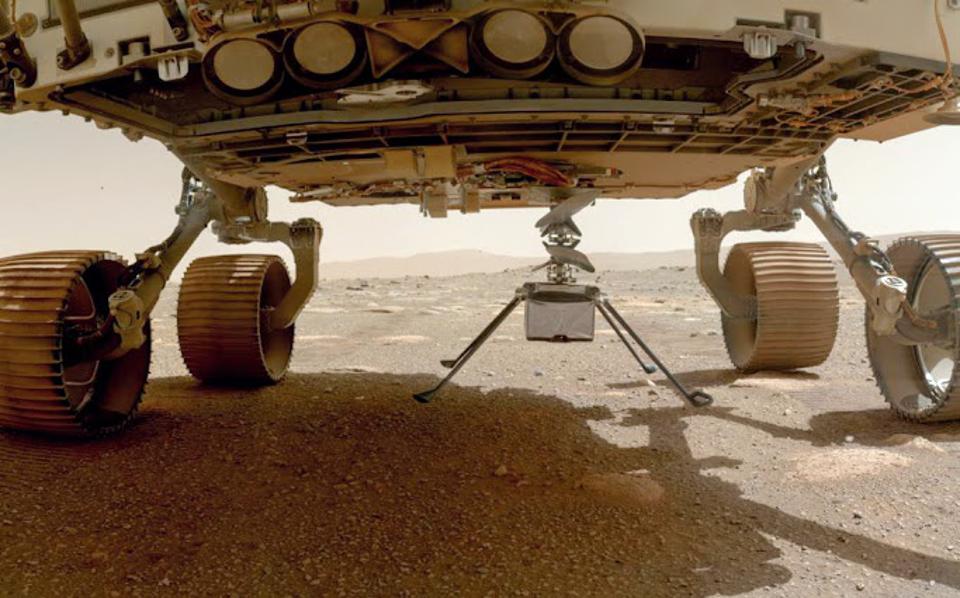
Mars Ingenuity's New Mission Will Push It To The Brink of Death
Share
Ingenuity the helicopter rose into the thin atmosphere of Mars by using its blades to push against it. It then hovered above the surface of the planet and plunged down to its surface.
Many NASA robotic explorers have visited other worlds. Some have simply passed by. Others have entered orbit. Very few have landed. And even less have driven across alien surfaces.
Now a machine has flown through alien skies for the first time. Ingenuity made the flight look simple, but taking off in the super thin Martian air is not easy. The feat was equivalent to flying more than 100,000 feet in the sky. In comparison, this is much higher than the vast majority of aircraft can fly on Earth.
The historic event was documented on both the Ingenuity and Perseverance rovers' cameras, which provided a glimpse into planetary exploration's first technologies.
“What the Ingenuity team has done is given us the third dimension,” said Michael Watkins, the NASA Jet Propulsion Laboratory (JPL) director, in a press briefing on Monday. “They’ve freed us from the surface now forever.”
“What the Ingenuity team has done is given us the third dimension,” said Michael Watkins, the NASA Jet Propulsion Laboratory (JPL) director, in a press briefing on Monday. “They’ve freed us from the surface now forever.”

Ingenuity snaps a picture of its own shadow from midair, with a camera it uses for navigation.
Scientists have proven that Ingenuity can handle a fraction of Earth’s atmosphere thickness.
As the project progresses, engineers will launch an array of increasingly daring missions to find out just how capable their space copter is. The team will take the craft to heights of 16 feet, and then actually launch it somewhere.
Ingenuity will test its sideways gliding capability by as much as 6 feet (again,) followed by 160 feet (again,). As the helicopter continues on its journey, Aung hopes that it will venture a third of a mile or even further away from its take-off point.
She described the upcoming flight program that will precisely identify the edge of what’s currently possible for Martian aviation.
“We want to push against the wind, we want to push against the speed. We expect it will meet its limit,” Aung said. “We want to know what the limits are.”
The Choppers Cutting Edge

The extreme limits of Ingenuity data could become invaluable if Ingenuity is to launch a new era of planetary exploration.
Sojourner was a shoe box-sized rover thrust into the back of the Mars Pathfinder's stationary orbiter during the 1997 mission.
This shoebox-like machine housed Pathfinder’s major science instruments. It was the first vehicle to roll down the ramp and drive on a different planet.
Curiosity and Perseverance, the SUV-sized Mars rovers, are currently at the center of NASA’s Mars exploration program. Perhaps one day, rotors will prove just as important in the search for Martian life as wheels do today.
Justin Maki, imaging scientist for Perseverance, who helped film Ingenuity’s flight from Perseverance, parked just 230 feet away, added, “The skeptics soon get converted and it soon becomes the new way to do things.”
It remains to be seen how future mission planners and researchers use the power of flight, but at least theoretically, there is no limit.
The Smithsonian National Air and Space Museum curator of Planetary Exploration, Matt Shindell, says that it is not every day that NASA gets to play with brand new technology on other planets.
One advantage of using scouts over rovers in the future could be to foresee new rovers that need to be sent out in the next few years.
They move them very slowly and very carefully because the team that drives them is worth multi-billions of dollars.
However, helicopters do not run into rocks or get stuck in sand traps, enabling speeds and distances unheard of on Mars. Ingenuity will cover a distance similar to the distance Curiosity has traversed in months.
If they can bulk up, other Ingenuity descendants might go it alone, as well. Bob Balaram, chief engineer of the helicopter, believes that future Martian aircraft could grow as heavy as 50 pounds, giving them the ability to carry around 10 pounds.
Helicopters with cameras and other scientific instruments could show us a different side of Mars.
The Red Planet has dramatic topography that is not suited for wheeled exploration. Shindell hopes to see future rotorcrafts access its deep canyons and steep mountains.
“You’re not going to drive a rover up the side of a volcano,” he says.

The benefits are not limited to Mars alone. There will be a need for different aircraft types in unique atmospheres. It should be relatively easy for Titan's upcoming Dragonfly drone mission, currently scheduled for arrival in 2036, to handle the thick atmosphere on the moon of Saturn.
Nevertheless, the operational lessons JPL has learned about design, testing, and achieving a successful takeoff in an unfamiliar environment might be of assistance. The specific technology that Ingenuity possesses may be applicable to a terrestrial setting. No helicopter has ever reached a height higher than around 15km. You’d need to see the earth at a height of more than 50 kilometers to see low atmospheric pressure like what Ingenuity faced. It is possible that Mars technology will also bring terrestrial crafts to new heights by bringing Mars tested technology back to Earth.
“There’s interesting science there that I’m sure our earth science friends are thinking about,” said Thomas Zurbuchen, associate administrator of NASA’s Science Mission Directorate.




